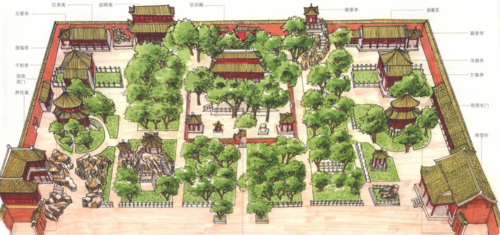
The Central Axis Design of the Imperial Garden
A Microcosm of Cosmic Order
The Imperial Garden, nestled within the Forbidden City, is a testament to the meticulous planning and symbolic representation ingrained in traditional Chinese architecture. At the heart of this meticulously crafted oasis lies the central axis, a powerful design element that dictates the garden's spatial arrangement and reflects the cosmological beliefs of the imperial court.
The North-South Axis: An Embodiment of Imperial Power
The central axis of the Imperial Garden aligns perfectly with the north-south axis of the Forbidden City, extending the symbolic line of power that permeates the entire palace complex. This deliberate alignment reinforces the emperor's position as the Son of Heaven, the intermediary between the celestial realm and the mortal world. Just as the North Star held a position of supreme importance in the night sky, so too did the emperor occupy the highest position within the earthly realm.
Symbolic Structures Along the Axis:
This central axis is not merely an abstract line; it is punctuated by a series of significant structures that reinforce its symbolic importance.
- The Gate of Divine Might (Shenwumen): Marking the southern entrance to the garden, this gate serves as a ceremonial threshold, separating the bustling outer court from the serene retreat of the Imperial Garden.
- The Pavilion of Imperial Peace (Qianlong Shi): Situated directly on the axis, this pavilion served as a place for the emperor and empress to rest and enjoy performances. Its central location reinforces its importance as a focal point within the garden's design.
- The Hall of Imperial Supremacy (Huangji Dian): Though not technically within the Imperial Garden, this throne room, situated directly north and aligned with the garden's central axis, serves as the culmination of the axis. This architectural alignment emphasizes the interconnectedness of these spaces and reinforces the emperor's dominion over both the political and personal realms.
Symmetry and Balance: Reflecting Harmony and Order
The central axis serves as the backbone of the garden's symmetrical layout. Buildings, pathways, and even the arrangement of trees and flowers adhere to a strict bilateral symmetry, with the axis acting as the mirror line. This meticulous design reflects the Confucian ideals of harmony, balance, and order that were paramount in Chinese society. This balance extends beyond the physical, representing a desired balance between yin and yang energies, essential for good fortune and prosperity.
A Journey of Ascent and Descent:
The central axis also orchestrates a carefully choreographed experience for visitors, particularly the emperor and his entourage. Entering from the south, one progresses northward along the axis, ascending staircases, and passing through pavilions and gates. This journey symbolizes an ascent in status and a movement towards the sacred, culminating in the throne room. The return journey south mirrors this experience, representing a descent back into the earthly realm.
Conclusion:
The central axis of the Imperial Garden is not merely a design element; it is the very essence of the garden's symbolic meaning. It embodies the cosmological principles, political ideologies, and aesthetic values of imperial China. Even today, the central axis offers visitors a glimpse into the minds of the emperors who once strolled these paths, seeking moments of peace amidst the grandeur and weight of their imperial responsibilities.
Q&A
1. What is the significance of the north-south alignment of the Imperial Garden's central axis?
Answer: The north-south alignment mirrors the Forbidden City's axis, emphasizing the emperor's position as the Son of Heaven, ruling in alignment with the celestial order.
2. How does the design of the Imperial Garden reflect the principle of yin and yang?
Answer: The garden's symmetrical layout, with its balanced arrangement of structures and natural elements, visually represents the harmonious coexistence of yin and yang energies, vital for good fortune in Chinese cosmology.
3. What is the experience like for a visitor traversing the central axis of the Imperial Garden?
Answer: The journey along the central axis is a carefully orchestrated experience. Moving from south to north, one symbolically ascends towards the sacred, culminating in the throne room. The return journey mirrors this, representing a descent back to the earthly realm.